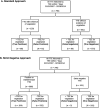An Approach to Improve the Negative Predictive Value and Clinical Utility of Transthoracic Echocardiography in Suspected Native Valve Infective Endocarditis
- PMID: 26850679
- PMCID: PMC6052444
- DOI: 10.1016/j.echo.2015.12.009
An Approach to Improve the Negative Predictive Value and Clinical Utility of Transthoracic Echocardiography in Suspected Native Valve Infective Endocarditis
Abstract
Background: In patients with suspected native valve infective endocarditis, current guidelines recommend initial transthoracic echocardiography (TTE) followed by transesophageal echocardiography (TEE) if clinical suspicion remains. The guidelines do not account for the quality of initial TTE or other findings that may alter the study's diagnostic characteristics. This may lead to unnecessary TEE when initial TTE was sufficient to rule out vegetation.
Methods: The objective of this study was to determine if the use of a strict definition of negative results on TTE would improve the performance characteristics of TTE sufficiently to exclude vegetation. A retrospective analysis of patients at a single institution with suspected native valve endocarditis who underwent TTE followed by TEE within 7 days between January 1, 2007, and February 28, 2014, was performed. Negative results on TTE for vegetation were defined by either the standard approach (no evidence of vegetation seen on TTE) or by applying a set of strict negative criteria incorporating other findings on TTE. Using TEE as the gold standard for the presence of vegetation, the diagnostic performance of the two transthoracic approaches was compared.
Results: In total, 790 pairs of TTE and TEE were identified. With the standard approach, 661 of the transthoracic studies had negative findings (no vegetation seen), compared with 104 studies with negative findings using the strict negative approach (meeting all strict negative criteria). The sensitivity and negative predictive value of TTE for detecting vegetation were substantially improved using the strict negative approach (sensitivity, 98% [95% CI, 95%-99%] vs 43% [95% CI, 36%-51%]; negative predictive value, 97% [95% CI, 92%-99%] vs 87% [95% CI, 84%-89%]).
Conclusions: The ability of TTE to exclude vegetation in patients is excellent when strict criteria for negative results are applied. In patients at low to intermediate risk with strict negative results on TTE, follow-up TEE may be unnecessary.
Keywords: Echocardiography; Infective endocarditis; Screening; Transesophageal echocardiography.
Copyright © 2016 American Society of Echocardiography. Published by Elsevier Inc. All rights reserved.
Figures



Comment in
-
Infective Endocarditis: A Deadly Disease if Diagnosed Too Late.J Am Soc Echocardiogr. 2016 Apr;29(4):323-4. doi: 10.1016/j.echo.2016.02.010. J Am Soc Echocardiogr. 2016. PMID: 27037983 No abstract available.
References
-
- Li JS, Sexton DJ, Mick N, Nettles R, Fowler VG, Jr, Ryan T, et al. Proposed Modifications to the Duke Criteria for the Diagnosis of Infective Endocarditis. Clin Infect Dis. 2000 Apr 1;30(4):633–8. - PubMed
-
- Nishimura RA, Otto CM, Bonow RO, Carabello BA, Erwin JP, Guyton RA, et al. 2014 AHA/ACC Guideline for the Management of Patients With Valvular Heart Disease: executive summary: a report of the American College of Cardiology/American Heart Association Task Force on Practice Guidelines. Circulation. 2014 Jun 10;129(23):2440–92. - PubMed
-
- Baddour LM. Infective Endocarditis: Diagnosis, Antimicrobial Therapy, and Management of Complications: A Statement for Healthcare Professionals From the Committee on Rheumatic Fever, Endocarditis, and Kawasaki Disease, Council on Cardiovascular Disease in the Young, and the Councils on Clinical Cardiology, Stroke, and Cardiovascular Surgery and Anesthesia, American Heart Association: Endorsed by the Infectious Diseases Society of America. Circulation. 2005 Jun 6;111(23):e394–434. - PubMed
-
- Shively BK, Gurule FT, Roldan CA, Leggett JH, Schiller NB. Diagnostic value of transesophageal compared with transthoracic echocardiography in infective endocarditis. J Am Coll Cardiol. 1991 Aug;18(2):391–7. - PubMed
-
- Shapiro SM. Transesophageal echocardiography in diagnosis of infective endocarditis. CHEST J. 1994 Feb 1;105(2):377. - PubMed
Publication types
MeSH terms
Grants and funding
LinkOut - more resources
Full Text Sources
Other Literature Sources
Medical

